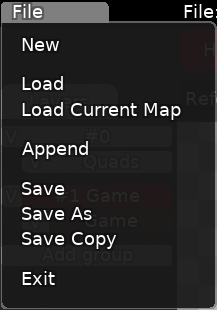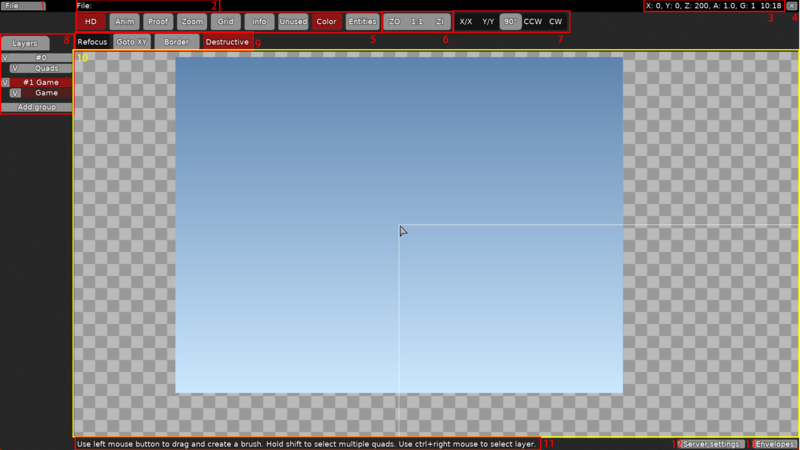地图制作
地图制作过程大致可分为头脑风暴,贴图设计以及地图测试三大环节。Teeworlds所属的每个模组(游戏模式)都将游戏地图作为玩法的基础。
头脑风暴环节要求地图制作者通过不凡的想象力,来制作出有创意、娱乐性高的地图实体;
贴图设计环节要求地图制作者为地图添加漂亮的外观,设计过程中一般要符合大众审美,且各个贴图所表示的信息应足够清晰且不会产生歧义,同时整体设计风格也要一般要符合游戏画风;
地图测试环节要求地图制作者完整将自己所制作的地图进行测试,以便发现当前地图中尚未察觉出的玩法问题或贴图设计问题等等。
玩家可以点击主菜单中的编辑器,来进入地图编辑器界面。
在游戏内的任何界面下,按下ctrl+⇧ Shift+E也可以直接进入地图编辑器界面。
DDNet地图制作准则
如果玩家最终想让自己的地图在DDNet服务器上发布,那么玩家必须遵守如下准则去制作地图。在地图上传至DDNet的Discord服务器之前,请确保玩家已经完整地测试过地图,地图各关卡运行和操作流畅,同时设计环节也已完全竣工。
在游戏体验方面,我们要求:
每个关卡都应有足够的空间供玩家进行舒适地操作;
地图整体难度应保持平衡,不得出现较大的波动(例如在一个中阶地图当中不能插入高星高阶地图甚至是疯狂地图的操作);
在容易造成失败的关卡当中,应有办法让其他玩家进行救援;
关卡操作不得过于精确或仅仅为难而难;
不得过度使用特殊游戏实体,同时不得将特殊实体用在修复地图关卡漏洞上;
不得故意误导或混淆关卡操作方式;
关卡不得利用游戏物理机制上的Bug来实现。
在视觉效果方面,我们要求:
所有玩家过关需要的实体都必须在贴图当中清晰地表示出来;
不同实体的贴图或标记必须要易于区分;
前景与背景必须要有明显的区别;
不要将对比度和饱和度调得太高,否则看上去会很不舒服;
在贴图层存在标志,提示或警告时,必须在实体层当中添加“Turn Off Entities(关闭实体层)”的标记;
如果使用了其他地图当中的素材,则需要得到素材原作者的许可后才能使用。
其他层面上,我们要求:
所有的玩家都必须要经过起点;
每张地图上都应有时间检查点。
额外注意:
在上述规则的基础上,关卡的独特性和创新性至关重要,同时也要保证地图有着优秀的贴图设计。一个简单但有良好关卡设计和优秀视觉效果的地图,相比于一个充满各式各样复杂问题的地图来说,会有更高的概率被选中并上传至DDNet服务器当中。
编辑器界面总览
Next, we will explain the purpose of each button in the editor interface one by one according to the content number on the picture.
[1] File

点击后出现的下拉菜单中:
- New ctrl+N: New map file.
- Read ctrl+I: reads the map file.
- Load Current Map ctrl+alt+I: If you enter the editor screen during the game or during playback, clicking this button will load the map used in the current game.
- Append ctrl+A: adds all the materials in a map file to the current map.
- Save ctrl+S: saves the current map.
- Save As ctrl+⇧ Shift+S: saves the current map under another file name, while continuing to edit the map under that file name.
- Save Copy ctrl+⇧ Shift+alt+S: saves the current map under another file name, but continues to edit the map under the original file name. When the map name used when saving a copy duplicates an existing file, the map will continue to be edited with that file name after completing the save.
- Exit ctrl+⇧ Shift+E: Exit the editor interface.
[2] File name
This area displays the name of the map file currently being read and its file save path.
[3] Editor state info
This area displays the attributes of the current map editor.
- X, Y: indicates the current position of the map editor where the mouse cursor is located, in grid.
- Z: indicates the scale value of the current map, which defaults to 200 when the map is loaded in the editor.
- A: indicates the playback speed of the current map animation, default is 1.
- G: indicates the size of the current map grid lines, default is 1.
- 10:18: local time.
[4] Exit
Exit the editor interface. ctrl+⇧ Shift+E
[5] Display functions
Display functions changing how the map is displayed.
- HD (Show High Details) ctrl+H: preview the appearance of the current map in high quality mode.
- Anim (Show animation) ctrl+M: previews the animation effect set by the current map.
- Proof (Show field of view boundary) ctrl+P: previews the maximum field of view of the player in the default zoom level.
- blue circle: indicates the player's actual position
- the red box line and green box line indicate the maximum range that can be observed at different resolutions
- the white box line indicates the maximum range that can be observed with dynamic view turned on.
- Zoom: preview what the player sees in the actual game.
- Grid ctrl+G: turns on grid lines.
- Info ctrl+I: previews the details of the entity or texture, including but not limited to the ID of the entity or texture, the texture animation track, and the texture deformation.
- (Unused) ctrl+U: allows placement of unused mappings in the map, a feature not commonly used in modern maps anymore.
- Color: previews the color set by the current brush, after closing the brush will show the original color match, but does not affect the color set by the placed mapping.
- Entities: select the category of entity layer that needs to be used for the current map. Depending on the game mode applied to the map, the entity layer selected in the editor should also be different.
[6] Zoom
Field of view adjustment functionality, descriptions in order from left to right.
Expanding or scaling the field of view by clicking buttons or pressing shortcut keys has no maximum and minimum scale value, and the scale value can even reach negative values. When the scale value is negative, the map as a whole is upside down.
- ZO (Zoom out) numpad-: expands the field of view of the operation area by 50 points of scale value each time.
- Scrolling the mouse wheel down also expands the field of view by 20 scale points per scroll, expanding the field of view in this way up to a maximum of 2000 scale points.
- 1:1 numpad*: restores the field of view to the default scale value.
- ZI (zoom in) numpad+: reduces the field of view of the operation area by 50 points of scale value at a time.
- Roll the mouse wheel upward to also reduce the field of view by 20 scale points per scroll frame, and reduce the field of view in this way up to 10 scale points.
[7] Brush functionality
Descriptions from left to right:
- X/X (Horizontal flip) N: flips the contents of the brush horizontally.
- Y/Y (Vertical flip) M: flips the contents of the brush vertically.
- 90° (Rotation angle): the angle at which the content in the brush is turned each time it is rotated, which can be modified by holding down this button and sliding the mouse left and right, holding down ⇧ Shift during the modification process for more precise modification.
- You can only choose from 90°, 180° and 270° angles.
- CCW (Counterclockwise rotation) R: rotates the contents of the brush counterclockwise at an angle.
- CW (Clockwise rotation) T: rotates the content in the brush clockwise at a certain angle.
[8] Layers/Images/Sounds management
In this area you can manage different groups of layers including the physics layer. By clicking on the top button "Layers", you can add images and sound resources to the map. Layer management area, here is responsible for managing the map's layer groups and layers, as well as the invocation of the mapping material, picture material, and sound material. Pressing → will also switch to the image management interface, or pressing ← will switch to the sound management interface
Layers
- Layers (left click) →: Switch to Image management
- Layers (right click) ←: Switch to Sound management
- Click "Add group" at the bottom to add a new group.
- Right-click a group to set the parameters of that group
- Right-click a layer to set the parameters of that layer
Images
- Images (left click) →: Switch to Sound management
- Images (right click) ←: Switch to Layer management
- Click the Add button to add image clips from the default clip folder to the map file.
- Embedded area means the clips of this series have been embedded in the map file, when downloading the map, this kind of file will be included in the map file volume.
- External area means that the material of this series is located outside the map, it is the default material in the game, when downloading the map, this kind of file will not be counted in the map file volume. When the map needs to call the image material of this area, it will directly call the file with the same name from the player's local default material library.
- Regardless of the location of the clip, when the clip file is white or red (selected), it means the clip is being used by the map; when the clip file is blue or purple (selected), it means the clip is not yet used by the map.
- Left-click on a file that has been added to preview the image in the right workspace, and right-click on the file to perform the following actions.
- Readd: Overwrite the clip by calling a file with the same name directly from the default clip library.
- Replace: select a clip file to overwrite the clip.
- Remove: removes the clip file.
- When right-clicking on a file in the External area, an additional Embed option will appear to move the file into the Embedded area.
Sounds
- Sounds (left click) →: Switch to Layer management
- Sounds (right click) ←: Switch to Image management
- Click the Add button to add sound clips from the default clip folder to the map file. Currently DDNet game editor only accepts opus format audio files.
- Right-click on a file to perform the following actions.
- Readd: Overwrite a clip by calling a file with the same name directly from the default clip library.
- Replace: select a clip file to overwrite the clip.
- Remove: Remove the clip file.
[9] Context dependent actions
Additional buttons that will change depending on the selected layer.
On all layers
When any layer is selected, the following buttons appear:
- Refocus home: immediately focuses the view to the upper left corner of the map.
- Goto XY: immediately focuses the view to a specific coordinate of the map. Clicking this button sets the coordinate in its drop-down menu, and then clicking the Go button focuses the view to that coordinate.
- Destructive mode ctrl+D: When Destructive mode is enabled, the area the brush passes over will be completely covered and the texture of this area will be replaced; when Destructive mode is disabled, the area the brush passes over will only be filled with the location that is not filled with the texture.
- When Game or Tile layer is selected: Add Border: Adds a two-tile wide border to the current layer, using the texture of the selected layer's No. 2 map.
- When Switch layer is selected: Switch ctrl+A: Set the number of the next placed switch layer entity. In the drop-down menu: Number is used to set the number, Delay is used to set the number of additional information, and F (shortcut: ctrl+F) is used to automatically set the unused number.
- When Speedup layer is selected: Speedup ctrl+A: Set the parameters for the next placement of the speedup entity. In the drop-down menu, Force is used to set how much speed the belt can provide, Max Speed is used to set the maximum speed you can have at the belt, and Angle is used to set the direction of the belt.
- When the Tele layer is selected: Tele ctrl+A: Sets the number of the next entity to be placed in the transmission area. The drop-down menu: Number is used to set the number, and F (shortcut: ctrl+F) is used to automatically set the unused number.
- When Tune layer is selected: Tune ctrl+A: Set the number of the next placed adjustment zone entity. In its drop-down menu, Zone is used to set the number.
- When the Quads layer is selected: Add Quad ctrl+Q: Adds a picture set by the current layer to the workspace. If no picture is set for that layer, a plain white square of 2*2 grid size is added by default.
- When the Sounds layer is selected. Add Sound ctrl+Q: Adds a sound set by the current layer to the workspace.
[10] Mapping area
Workspace, where all the components needed for the map are placed.
[11] Hint area
When the mouse hovers over a button, the hint area will appear with the function of the button and a keyboard shortcut for the button function.
[12] Server setting
You can change Map settings to change server behavior. For example setting a map to be a solo map.
[13] Envelopes
Envelope animation: this is responsible for setting the animation effect in the map.
Explain in detail what is marked "to be explained in detail" above. Full explanation of the features in the editor. Discuss the similarities and differences between modern maps and traditional and classical maps, or discuss their backstories.
Write a short tutorial on mapping.
External Resources
- Mapping ABC by Index
- Link list including lots of mapping resources by Index
- DDRaceNetwork - How to Use the Map Editor by Nick Joy
- Teeworlds - How to map a DDRACE map. - Part 1 by Aoe
- Teeworlds - How to map a DDRACE map. - Part 2 by Aoe
- Maps Envelope Tutorial by 2gethR
- Automapper Tutorial by timakro
- Mapper rules for DDNet map testing process by jao

